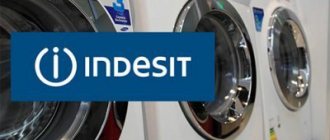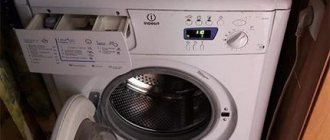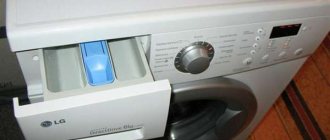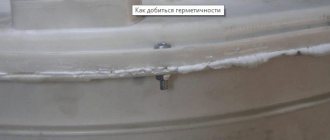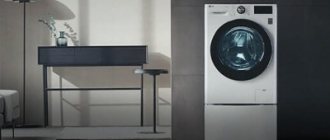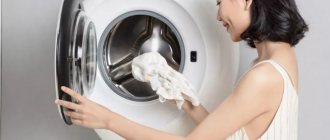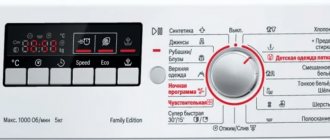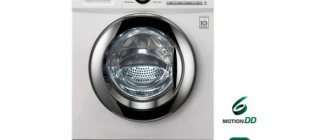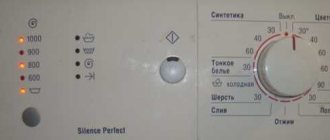Appearance and a variety of washing modes are not the most important parameters that guide buyers. Against the backdrop of the current general rise in prices for utilities, the issue of saving electricity during the operation of household appliances is very relevant.
The electrical power consumption of a washing machine is an important parameter that affects energy saving. When choosing and purchasing household appliances, this indicator will determine how energy efficient a particular device will be.
This criterion particularly applies to the choice of washing machine. After all, this is not just a piece of technological development, it is part of your everyday life, requiring almost daily energy consumption.
Your assistant should serve for a long time, bringing only pleasure in use.
How to determine the power of a washing machine?
First you need to understand which parts of a given household appliance consume electricity the most:
- The electric motor is the “heart” of the washing machine . The task of this element is to give rotation to the drum. The main types of motors used in modern devices are commutator, asynchronous and direct drive. Average power consumption ranges between 400 and 800 Watts (0.4 to 0.8 kW). During normal washing, energy consumption is less, during spinning - more.
- Heating element - serves to heat water in the tank . It fully automates the washing and drying process. The quality of washing certain items depends on choosing the right temperature. Therefore, the heating element may not turn on at all during washing (rinsing in cool water) or consume power for the entire “coil” - washing at a temperature of 90–95 degrees. Each heating element installed in a washing machine has an installed power. It ranges from 1.7 to 2.9 kW. The higher the power, the faster the water in the tank will heat up.
- Pump (pump) - designed to pump out water at various stages of washing. The power consumption of such pumps varies from 25 to 40 watts.
- The control panel , electronic module, programmer, various sensors, starting capacitors, light bulbs and other radio components are elements that together consume no more than 5 - 10 Watts.
In turn, they will consume the amount of energy corresponding to the choice of washing program.
The programmed modes differ from each other in temperature, washing duration, intensity, number of drum revolutions during washing and spinning, additional options (number of rinses, etc.).
Affects power consumption and weight of loaded items and fabric types.
Power determination
- You can determine how many kilowatts of electricity your machine will consume based on its technical specifications. They are located on the case sticker or in the manual manual.
- A household appliances consultant can explain your questions in detail.
- You can also find out the power by the letter marking of the washing machine of a particular model. It is indicated on the EU energy efficiency label - DIRECTIVE 2009/125/EC, indicating the basic consumer properties of the product.
In this video, you will be told a lot of useful information about energy consumption, including for washing machines. Enjoy your viewing!
Weight of the most popular models
Indesit washing machines with a load of laundry up to 5 kg are quite spacious, medium-power units. One of their main advantages is the balance of practicality and affordability. Let's look at the most popular units in this segment.
Front loading model. Among the main features is the Push{amp}amp;Wash mode, which allows you to save time when choosing the optimal mode. Using this option, the user receives a turbo-programmed service - a wash, rinse and spin cycle starts in 45 minutes, and the washing temperature is automatically selected taking into account the type of fabric.
In total, the machine has 14 modes, including anti-crease, down mode, and super rinse. The device operates silently and does not vibrate even when squeezing large items. By the way, the spin intensity is adjustable, the maximum value is 1000 rpm. At the same time, the unit itself has a compact size - its width is 60 cm with a depth of 35 cm and a height of 85 cm.
Indesit IWSC 5105
Another popular, ergonomic and affordable model. This unit has a little more operating modes - there are 16 of them; in addition, the design is equipped with a removable lid, so the model can be “built in” to a set or other furniture. The energy consumption class, washing and spin levels are similar to those of the previous machine.
During the washing cycle, the unit consumes 43 liters of water, the maximum spin speed is 1000 (this parameter is adjustable). There is no emergency water drain function, which is seen as a “minus” for many users. In addition, there is no locking against accidental pressing, noise is felt during operation, and an unpleasant “plastic” smell appears when washed in hot (from 70 C) water.
We suggest you familiarize yourself with How to replace heating elements in a washing machine
Indesit IWSD 51051
A front washing machine, the distinctive characteristic of which is its support for the bio-enzyme phase of washing. In other words, it is possible to wash things in this machine using modern biological detergents (their feature is to remove contaminants at the molecular level). The model is characterized by high washing efficiency (class A) and economical consumption of electricity (class A) and water (44 liters per 1 cycle of operation).
The user has the opportunity to choose the spin speed (1000 rpm maximum) or completely abandon this function. A large number of programs (16), delayed start for 24 hours, control of tank imbalance and foam formation, partial protection against leaks - all this makes the operation of the machine more convenient and comfortable.
Among the shortcomings are noticeable noise when squeezing, the lack of a water heating function in quick wash mode.
Indesit BTW A5851
A model with a vertical loading type and a narrow, 40 cm wide body. One of the advantages is the ability to reload laundry, which provides additional comfort. Spin speed up to 800 rpm, water consumption – 44 liters per cycle, number of washing modes – 12.
Among the “minuses” are the detergent remaining in the tray and insufficient spin quality.
Washing machine repair specialists say that the best models are Indesit and LG, which perfectly balance weight with functional features. Below is a list of different models with total weight, front loading:
- Indesit - for models from Italy, the weight depends on the depth, standard ones with dimensions of 85x60x42 cm weigh from 62.5 to 62.8 kg, narrow versions with a depth of 33 cm - 52.5 kg.
- Ariston - Italian craftsmen have achieved a slight variation in weight depending on the dimensions, it is 63-70 kg.
- Samsung - Korean engineers, with the help of innovations, have made the maximum weight of their products within the following limits, depending on the depth: 55-65 kg.
- Kandy - product weight with standard parameters - 63.5-64.5 kg.
- Bosch - the famous brand from Germany weighs within the following range: 64-66 kg.
- LG is a well-known brand from South Korea, here everything also depends on the depth: 36-64 cm - respectively 56-73 kg.
- Zanussi - from Slovenia, weight varies between 52.5-54 kg.
Which washing machine is better - top-loading or front-loading?
Energy consumption classes
The power consumption of washing machines is calculated practically. The calculation was based on a full cycle of washing cotton laundry at a temperature of 60 o C and a loaded weight of 6 kg.
The classes indicate the efficiency index “C” for the use of electricity (kWh per 1 kilogram). The European Community has developed an energy efficiency scale from letter “A” to letter “G”.
“A” and “B” are the most energy-saving classes. “C”, “D” and “E” are average in terms of energy savings. "F" and "G" are the lowest available.
Energy efficiency of standard household washing machines
Modern popular models of washing machines are the result of modern technologies
The parameter of interest is the amount of energy consumption.
Full-size front-loading models:
Washing machines wear out and break down over time. Most often they are simply thrown into a landfill. However, in many cases, parts from a washing machine can come in handy. There are many options for the second life of an electric motor. It all depends on the skills, capabilities and imagination of the home craftsman. In this article you will learn where you can use the motor from a washing machine, if it is in working condition. Let's look at what homemade products you can make from a washing machine engine.
conclusions
A washing machine with a 5 kg load of laundry is a very practical purchase. For a low cost you get a full-fledged high-quality device with a full range of programs and good washing. I specifically reviewed budget models so that everyone could choose the best option for themselves.
The safest model
Washing machine BEKO WKB 50801M is the safest model. It has partial protection against water leaks (only on the body), child locking and protection against power surges. With such a set, you will not be afraid to leave the machine running at night or in your absence and constantly guard its operation so that the child does not accidentally press the buttons. Protection against power surges will be appreciated by those who have problems with this in their home and whose equipment is constantly on fire.
The best spin
The LG F-12B8MD1 washing machine has the highest quality spin – 1200 rpm, this is efficiency class B. This is a good indicator, considering the low cost of the device.
Electric motor for a grinder or emery
Purchasing a ready-made sharpening machine is not always possible, primarily due to the high price, and in this case an electric motor from a washing machine or other equipment literally becomes indispensable.
Read also: What to make an anvil from with your own hands
A lot of effort requires the correct layout of the future unit, as well as solving such a technical problem as attaching a grindstone to the motor shaft. In many cases, there is no thread on it, and the diameters of the shaft and the hole in the stone do not match. The usual way out is to use a special part, which must be ordered separately from a turner's workshop. This part may be called a flange, adapter, hub, etc.
The flange to be machined must be fitted onto the shaft and secured with a bolt. In addition, you will need a washer and a nut with threads directed in the direction opposite to the rotation of the motor shaft. Due to this, spontaneous tightening of the nut will occur during operation. Otherwise, the nut will quickly unwind and the stone will fly off.
If necessary, you can change the direction of rotation of the rotor. Asynchronous motors are installed in washing machines, therefore, it is enough to switch the corresponding windings, and the direction of rotation will change. To start the engine you will need a starter coil. If it is missing, then there is nothing to worry about: when you push the stone in the right direction, the device will work on its own.
To make a sharpening machine, it is not at all necessary to use high-power engines. 400 W is quite enough, and even 100-200 W. You should pay attention to the number of revolutions per minute, which should not exceed 3000. Otherwise, a motor with too high a rotation speed may lead to destruction of the grindstone. The best option is an electric motor with 1000 rpm.
Operating a homemade sharpening machine requires strict adherence to safety regulations. First of all, it is necessary to provide a protective casing to protect the worker from abrasive dust and small debris. For this purpose, metal 2.0-2.5 mm thick in the form of a strip folded into a half ring is suitable. In addition, it will be necessary to make a tool rest to ensure the support of the workpieces.
Converting a washing machine motor into a generator
Many home craftsmen are engaged in the manufacture of homemade generators using electric motors from household appliances, including washing machines. This task is fraught with certain difficulties, primarily of a technical nature. The services of a qualified turner will be required at the first stage of work.
The first step is to disassemble the asynchronous motor removed from the faulty washing machine. Then the core falls into the hands of a turner, who removes a layer of the element 2 mm deep on the machine. Then grooves are cut into the core to a depth of 5 mm, into which neodymium magnets will be inserted. It is recommended to make the grooves after purchasing the magnets, when their dimensions become known.
After completing all the work, it is necessary to attach neodymium magnets to the core. For this purpose, a template is made from tin or other thin metal. Its dimensions must match the dimensions of the core and the width of the slots, and it must fit exactly where the magnets will be installed. The magnets are located on the core at the same distance from each other and are secured with glue. In addition to the distance, the angle of inclination of each element is of great importance. Deviations from the standard dimensions can cause sticking, as a result of which the power of the generator is noticeably reduced.
Cold welding is used to fill the gaps between the magnets. Finally, the rotor surface is sanded with sandpaper, after which the device is completely assembled.
The assembled generator must be tested. For this purpose, you will need a small battery, a rectifier, a multimeter and a charge controller. The connection occurs according to a certain scheme. The charge controller is connected to the two generator windings through a rectifier. Then the controller and multimeter need to be connected to the battery.
For normal testing, it is necessary to ensure rotation of the electric motor rotor. This operation cannot be performed manually, so you must use a drill or screwdriver. The tool is connected to the motor rotor, after which rotation begins at a speed of approximately 800-1000 rpm. When the generator is assembled well, the output voltage is 220-300 V. A lower voltage indicates poor-quality rotor assembly.
After assembly and testing, the generator can be used. This will require the energy required to rotate the rotor. You can connect to a small internal combustion engine, such as a chainsaw or motorcycle. However, this method requires the purchase of energy. Therefore, other options are recommended, relatively inexpensive and environmentally friendly, related to the use of wind or water energy.
All home craftsmen should remember that the electric motor from a washing machine can be converted into a generator with a power of no more than 5 kW. Typically, such devices produce an average of 2 kW, sufficient for 1-2 rooms or a bathhouse. So it will not be possible to completely replace the electrical network with a homemade generator.
Lathe made from a washing machine engine
The motor from a washing machine is ideal for making a small wood lathe. The basis of the design is a frame, which can be made from a corner, profile pipes and other available materials. The dimensions of the frame are within 100 x 20 cm, with possible deviations in one direction or another.
The electric motor is quite suitable from an old washing machine, perhaps even from Soviet times. For example, the Vyatka-automatic was equipped with an asynchronous motor with two speeds at 400 and 3000 rpm. The connection can be made according to all known schemes, including using a capacitor.
Read also: Instructions for the electronics charger
The engine-to-frame mounting system is made individually. The most important thing is that the motor axis is parallel to the supporting structure. This can be done using washers, which, if necessary, are placed at the support points. The headstock is attached to the electric motor pulley. The tailstock and guides are also made from improvised materials. The axis of the tailstock must be parallel to the frame and the headstock, that is, it must be centered.
An important detail is the tool rest, which serves as a support for the cutting tool. It is necessary to ensure its movement along and across the frame, as well as reliable fixation during operation.
Electric motor for wood splitter
The basis of the design, as in a lathe, is the bed. It is made of a metal profile or square. The resulting site will consist of two zones - power and working. The power side is intended for installation of an electric motor. It must be securely fastened, since the main load falls on it.
The engine control unit is located in the same area. A dielectric plate is provided to accommodate the electrical components, and they themselves should, if possible, be placed in a plastic housing. The work area is made in the form of a table. The material used is steel sheet, 2-3 mm thick. At the boundary that conventionally separates both zones, a pedestal is mounted on which the shaft of the splitting cone is fixed. This part must not be mounted directly on the motor shaft.
The cone shaft is equipped with its own bearing support. In order to compensate for jerks and create torque, it is recommended to install a flywheel on the shaft.
After assembling the entire structure, you can begin connecting the electric motor. Asynchronous motors are most often used. In older units of this type, a separate winding is provided for starting. To determine it on the engine, you need to use a tester to measure the resistance on each winding one by one. The desired winding will have a higher resistance. It is directly involved in creating primary torque in the desired direction. If it is necessary to change the direction of rotation of the shaft, the connection points of the starting winding are swapped.
Modern electric motors start much easier. To turn it on and off, you can use a regular household machine.
Concrete mixer from a washing machine
A concrete mixer is necessary on the farm, especially in private and country houses. However, concrete mixers are quite expensive, so one of the solutions to the problem would be to make a concrete mixer from improvised materials. The best choice is a washing machine, not only the electric motor, but also the body itself.
The base must be reliable so that the container does not wobble during rotation. The lifespan of the unit depends entirely on this. An unstable base can cause the container to fall and other elements to fail. A metal structure is considered the most suitable. If desired, it can be equipped with wheels. All parts and components are connected to each other using bolts or welding. To install the electric motor, you need to provide special shelves with holes for mounting. The gearbox is also mounted on the same shelf, the pulley of which must be in the same plane as the engine pulley. Otherwise, the motor will experience overload.
Turning on and off a homemade concrete mixer is done using a batch switch. In most cases, a capacitor is present in the switching circuit. Thus, thinking about what homemade products can be made from a washing machine engine, any home craftsman will practically make the device that is most needed in the household.
When choosing a washing machine, the volume of the tank and the dimensions of the device are taken into account. But do not forget about the amount of electricity consumed. If you choose the right power of your washing machine, you can get high quality washing with minimal electricity consumption.
Tips for use
With careful and proper handling, a washing machine can last much longer and require repairs less often. To do this you need to follow a few simple rules.
- When connecting, you need to carefully select wires based on power, brand and cross-section. Two-core aluminum cables cannot be used, but copper or three-core cables can be used.
- For protection, you must use a circuit breaker with a rated current of 16 A.
- Grounding is not always available in houses, so you need to take care of it yourself. To do this, you will need to separate the PEN conductor and install a grounded outlet. It is better to choose a model with ceramic fittings and a high protection class, especially if the “washing machine” is in the bathroom.
- When connecting, do not use tees, adapters and extensions.
- If there are frequent voltage fluctuations, it is necessary to connect the washing machine through a special converter. A good option is an RCD with parameters no higher than 30 mA. The ideal solution would be to organize catering from a separate group.
- Children should not be allowed near the machine for playing with buttons on the control panel.
Do not change the program during washing.
How to determine the power of the device
Energy consumption depends on the rated power of the device. To find out the washing machine's power in watts, look at the sticker on the back of the washing machine. There are models of several classes based on the level of power consumption. The first letter before the power numbers will indicate which class the device belongs to based on the principle of economical consumption of electricity.
Taking into account the class of the washing machine, you can determine its approximate power. Class A is considered the most economical. The more advantages it has, the less energy it consumes. Class G consumes the most electricity. Classes are assigned to devices based on research results in kilowatt consumption per kilogram at a temperature of 60° Consumption according to classes
- Class A consumes 0.15 to 0.19 kW per hour to wash 1 kg of dry laundry.
- Class B consumes from 0.19 to 0.23 kW per 1 kg.
- Type C consumes from 0.23 to 0.27 kW.
- Type G consumes from 0.27 to 0.31 kW per 1 kg.
A separate class includes devices with clothes dryers.
Parameters affecting power
To understand how much electricity a washing machine consumes per hour, add up the energy consumption of all its components.
- An electric motor rotates the drum. During simple washing, consumption decreases, and during drying mode it increases. On average, the engine consumes 0.4–0.8 kW. Motors are commutator, direct drive and asynchronous.
- The heating element heats the water and makes the spin automatic. It is turned off in cold rinse mode, but works at maximum during heating and spinning. The more powerful the heating element, the less time it will take to heat the water. Heating element indicators: from 1.7 to 2.9 kW.
- The pump pumps out water according to the specified program. It requires 25 to 40 watts depending on the model.
- Electronic control consumes up to 10 watts, mechanical control takes no more than 5 watts. The control system includes starting capacitors, an electronic module, light bulbs, a programmer and other small radio elements.
Read also: Cutting speed when grinding formula
By adding the indicators of all components, you can find out the number of kilowatts consumed.
Types of motors
Asynchronous
- Simplicity of design.
- Easy maintenance.
- Fairly low noise level.
- Inexpensive cost.
Among the disadvantages, it can be noted that it has:
- low efficiency and;
- impressive in size.
Often such engines are used in inexpensive washing machines.
Collector
- Modest dimensions.
- Huge starting point.
- Simplicity of the control circuit.
- Short service life.
- Weakening of the magnetic field, which subsequently prevents the drum from rotating.
Direct drive
- Simplicity of design.
- It has an efficiency higher than that of other types of engines, while the vibrations of the machine are much lower.
- The sound level emanating from the MCA is also low.
- Due to the complexity of the circuit, manufacturers need to put in more effort, which increases the cost.
What affects energy consumption during washing?
The automatic machine has additional programs and functions that affect energy consumption.
- Washing mode. Each mode has washing parameters. The temperature of water heating, the duration of the process, and the intensity of drum rotation during spinning are set. A device with more power will heat the water faster and wring out clothes better. A device with a low consumption rate will perform the same job longer and will last less.
- Types of fabric. Different fabrics have different weights when dry and wet.
- Weight of laundry. Energy consumption directly depends on the degree of tank loading. The more laundry is loaded, the more electricity the device will need.
- Operating mode. The more often the device operates, the more current it consumes. Over time, plaque accumulates on the heating elements, causing the water to heat up longer and increasing costs.
- Additional functions. Modern automatic machines are constantly being updated with features that additionally consume energy.
To choose the most energy-saving mode, pay attention to all these factors. The cross-section of the cable with which it connects to the network depends on the power of the machine. For example, with an indicator of 2.2 kW, the current strength will be 10 amperes.
Features of automatic machines for 5 kg of laundry
As I already noted, automatic cars with such capacity are small units that take up very little space. Their depth usually does not exceed 40-45 cm. Such devices are ideally built into a kitchen set, so almost all of them have a removable lid for embedding. Naturally, in this case we are talking about machines with front-loading laundry - that’s what I’ll talk about in this review.
Another feature of the models is their good energy efficiency and low water consumption during the washing process. Since the devices do not have such energy-consuming additions as drying, they consume electricity in moderation.
I would like to note that I will consider budget models from various manufacturers, and their spin speed is not at the highest level, as is the case with all inexpensive devices. The highest value you can find is B, but usually even less - C or D. Also, given the low cost, the models do not have a display, which makes working with the device a little more difficult (you will not be able to track the time of the washing program) , but this is not critical.
How many kW per hour do different models consume?
Electricity prices are constantly rising, so consumers are increasingly purchasing machines with high energy efficiency. Let's consider several models of washing machines of different power with the most economical consumption.
- The LG F12B9LD model is made using direct drive electric motor technology. Class type A+, consumption is 1.02 kW per hour.
- Premium device Bosch WAY28790EU. It belongs to the optimal economy type A+++, consumes 1.31 kW per hour.
- Washing machine HOTPOINT ARISTON AQ114D697DEU/B. There is a function for automatic consumption optimization, classified as type A+++. Consumes 1.138 kWh
- Narrow device with front loading type INDESIT XWSA610517WUA. 16 washing programs, tank designed for 6 kg of laundry, class A+. Consumes 1.006 kW/h.
- Washing machine model LG F80C3LD. Front loading, spin quality class G, and only 0.75 kW per hour per 1 kg. Consumption type A++.
- Washing machine Bosch WVH228360OE. Front loading type, has a drying function, the tank holds 7 kg of clothes, electricity consumption class, consumption 5.67 kWh/kg, spin type B.
Indesit IWSB5085
Model Indesit IWSB5085 is a free-standing washing machine with the ability to be built-in. It has a front-loading type of laundry, designed for 5 kg. Has electronic control. Switching and selection of programs is carried out using rotary switches and buttons. Unfortunately, there is no display, so you won’t be able to see the remaining time of the program.
Energy consumption is quite low, using only 43 liters of water per cycle, and electricity – 0.95 kW/h, which is very little. It washes well, washing efficiency class A. There are 16 programs, although half of them are only variations of the main ones. For example, you can wash cotton in 6 different modifications - soaked, heavily soiled, dyed, delicate, etc.
In addition, there are programs for sportswear, silk, jeans, wool and a short Express 15 mode for refreshing lightly soiled laundry. The water temperature in various programs can be from 90 to 30 degrees. The spin is of poor quality, only efficiency class D, which means that the laundry remains very damp. The maximum number of possible revolutions is 800 rpm.
indesit-iwsb5085-1
indesit-iwsb5085-2
indesit-iwsb5085-3
Indesit IWSB5085 has a delay start timer from 3 to 12 hours. Protection against leaks is partial (body), there is control over imbalance (the laundry is evenly distributed throughout the drum before spinning) and foam level (preventing excessive foaming if there is too much detergent).
I would consider the advantages of the model:
- small price, but the quality of washing is good;
- consumes little water and electricity;
- there are several “sport” modes;
- there is a timer.
There are also disadvantages:
- noisy work;
- bad spin;
- Water remains in the powder tray.
Video presentation of washing machines of this series in a video from specialists:
https://youtube.com/watch?v=r0fV—zgcW0
How to save energy
Despite the characteristics of the washing machine and its power consumption in kW stated in the passport, you can reduce costs:
- Unplug the machine after finishing washing. When plugged into an outlet, it continues to use energy.
- Choose the right program depending on the main factors: amount of laundry, type of fabric and degree of soiling. This reasonable approach will save up to 30% of electricity consumption.
- Do not divide one load into several small washes. If the weight of the laundry allows, then it is better to load the laundry to the maximum value. According to the characteristics of washing devices, an incompletely loaded drum consumes 10-15% more energy.
- If you have the opportunity to dry your clothes outside, then there is no point in setting the spin/dry mode to full speed. This way you can save money and get fresh, sun-dried laundry.
- Clean the heating element from scale every six months. To do this, put an anti-scale agent in the powder compartment and turn on the “Cotton Wash” mode, selecting heating to a temperature of 60 ° C.
- For a small amount of clothing, you can use the “quick wash” program: its cycle is several times shorter than usual, consumes less water, and accordingly saves energy. This program is also called the partial occupancy or “few things” mode.
For a family of three, it is wiser to choose a small model to optimize energy costs. For large, high-volume washes, choose a Class A or B machine.
When choosing a washing machine, focus not only on appearance, variety of functions and enormous power. You can purchase a home assistant who will wash things efficiently and save money.
Criterias of choice
Before choosing a washing machine, familiarize yourself with the main criteria by which devices differ from each other: size, capacity, operating efficiency, control and software, additional features. I will dwell in detail on each point.
Dimensions and capacity
Washing machines, designed for 5 kg of laundry, come with front and vertical loading of the tank. I am considering frontal units, so I will describe their dimensions. The height of such machines is 85-90 cm, width - 60 cm, depth - 32-45 cm. Front-loading machines require a hatch in front of the machine with a transparent glass door through which the drum is visible.
You must take into account that it is necessary to leave space in front of the machine for comfortable opening of the loading hatch. The capacity of narrow models is 5-6 kg of laundry. This performance will be quite enough for 3-4 people.
Control and software set
These units have electronic control, which, depending on the model, has the following differences: the presence or absence of a display, the selection of programs and parameters can be made using a rotary lever, mechanical or touch buttons.
Regarding the set of programs, here we have, in addition to standard modes (cotton, synthetics, colored clothes, delicate wash), several additional options:
- pre-wash – the washing cycle is increased by 15 minutes, due to which heavy soiling is removed;
- degree of pollution – allows you to use exactly the amount of resources that is most efficient and economical. All you need to do is determine how dirty things are and set the appropriate parameters to the program;
- additional rinse – increases the amount of water in the rinse cycle to better rinse the detergent from the laundry fabrics. This option will be very relevant when washing children's clothes.
- special washing programs - children's clothes, sportswear, jeans, wool.
Efficiency and economy
Energy efficiency is an indicator of the electricity consumption of a device; the higher it is, the more economical the device is. The highest class is A++, these days this is not very uncommon, but still more often you will find A+ or A. The lowest rating is G, which means the most wasteful model. Of course, the higher the class, the more expensive the device.
The washing class of all appliances is usually A, that is, maximum. For the spin class, A is also the highest rating, but you may find B or C, which indicates an average spin job (the laundry is quite damp).
Additional features
Additional functions of the machine may include:
- delay start timer - allows you to set a convenient end time for washing;
- AquaStop system - a set of sensors that are triggered if there is a leak and block the access of water to the device;
- imbalance control – distribution of items in the drum before spinning for quieter and longer-lasting operation of the machine;
- surge protection - a device that stops the supply of electricity in the event of sudden power surges;
- Child lock – protects your nerves and device from little helpers. The system locks the door and control keys during operation.
